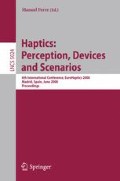Abstract
There is evidence that weight perception with one hand may be based on integrating effort signals resulting from muscular activity to support arm and weight against gravity [1]. When lifting an object with both hands, the magnitude of effort signals due to supporting the arms and weight against gravity may change in opposite ways: posture effort signals may increase due to the employment of both hands while weight effort signals may decrease due to sharing the weight between the two hands. Here, we report preliminary results of a study in which participants judged the heaviness of weights lifted with one and two hands. It was found that a weight lifted with both hands felt lighter than equal weights lifted with the left or right hand. However, unimanually lifted weights did not feel twice as heavy as bimanually lifted weights. This may suggest that an imperfect integration of both postural and weight signals could be taken into account when judging weight bimanually.
Access this chapter
Tax calculation will be finalised at checkout
Purchases are for personal use only
Preview
Unable to display preview. Download preview PDF.
References
Giachritsis, C.D., Wing, A.M.: The effect of gravitational torques about the shoulder joint on weight perception. In: Proceedings of EPS Conference 2007, University of Edinburgh, UK, Abstract, July 4-7, 2007, p. 84 (2007)
Brodie, E.E., Ross, H.E.: Sensorimotor mechanism in weight discrimination. Perception and Psychophysics 36(5), 477–481 (1984)
Flanagan, J.R., Wing, A.M., Allison, S., Spenceley, A.: Effects of surface texture on weight perception when lifting objects with a precision grip. Perception and Psychophysics 57(3), 282–290 (2007)
Flanagan, J.R., Bandomir, C.A.: Coming to grips with weight perception: Effects of grasp configuration on weight heaviness. Perception and Psychophysics 62(6), 1204–1219 (2000)
Kinoshita, H., Kawai, S., Ikuta, K.: Contributions and co-ordination of individual fingers in multiple finger prehension. Ergonomics 38(6), 1212–1230 (1995)
Kinoshita, H., Murade, T., Bandu, T.: Grip posture and forces during holding cylindrical objects with circular grips. Ergonomics 39(9), 1163–1176 (1996)
Author information
Authors and Affiliations
Editor information
Rights and permissions
Copyright information
© 2008 Springer-Verlag Berlin Heidelberg
About this paper
Cite this paper
Giachritsis, C., Wing, A. (2008). Unimanual and Bimanual Weight Discrimination in a Desktop Setup. In: Ferre, M. (eds) Haptics: Perception, Devices and Scenarios. EuroHaptics 2008. Lecture Notes in Computer Science, vol 5024. Springer, Berlin, Heidelberg. https://doi.org/10.1007/978-3-540-69057-3_49
Download citation
DOI: https://doi.org/10.1007/978-3-540-69057-3_49
Publisher Name: Springer, Berlin, Heidelberg
Print ISBN: 978-3-540-69056-6
Online ISBN: 978-3-540-69057-3
eBook Packages: Computer ScienceComputer Science (R0)

